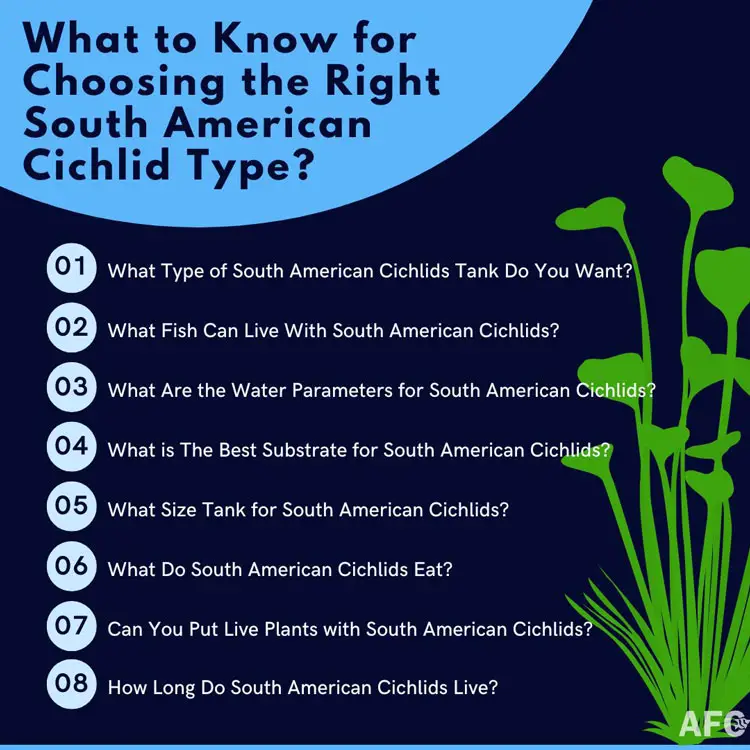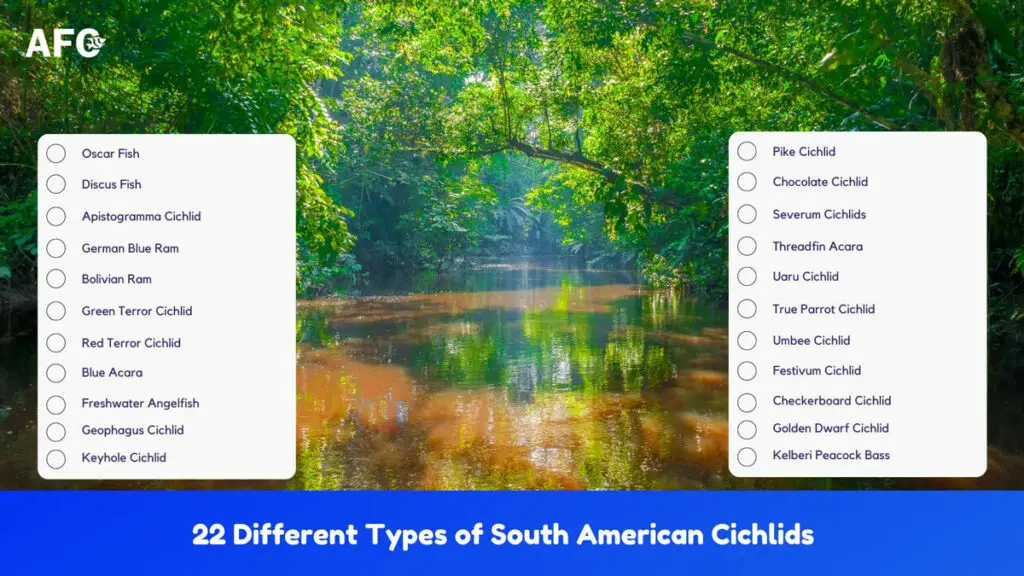South American cichlids are a diverse group of freshwater fish from the family Cichlidae, native to a variety of habitats all over South America, including rivers, lakes, streams, and swamps. There are approximately 600 described species in 46 genera; some are favorites in the fishkeeping hobby, and some are rare and uncommon.
The size of South American cichlids varies greatly, from the tiny Apistogramma dwarf cichlids that top out at only 3 inches in length to the Umbee cichlid that can reach a giant 20 inches (50 cm) long.
South American cichlids come in a wide range of colors and patterns. In recent years, new color morphs of some popular species have been developed by selective breeding at fish farms.
Many cichlid hobbyists choose South American Cichlids as their first fish, and it’s no wonder. Beyond their different sizes and striking beauty, they are relatively peaceful fish compared to African and Central cichlids.
These fish are also known for their highly intelligent nature and friendly personalities.
Below is a list of 22 types of South American cichlids most commonly kept as freshwater pet fish.
- Oscar Fish (Astronotus ocellatus)
- Discus Fish (Symphysodon spp.)
- Apistogramma Fish (Apistogramma spp.)
- German Blue Ram (Mikrogeophagus ramirezi)
- Bolivian Ram (Mikrogeophagus altispinosus)
- Green Terror Cichlid(Andinoacara spp.)
- Red Terror Cichlid (Mesoheros festae)
- Blue Acara (Andinoacara pulcher)
- Freshwater Angelfish (Pterophyllum spp.)
- Geophagus Cichlid
- Keyhole Cichlid (Cleithracara maronii)
- Pike Cichlid (Crenicichla spp.)
- Chocolate Cichlid (Hypselecara temporalis)
- Severum Cichlids
- Threadfin Acara (Acarichthys heckelii)
- Uaru Cichlid (Uaru amphiacanthoides)
- True Parrot Cichlid (Hoplarchus psittacus)
- Umbee Cichlid (Kronoheros umbriferus)
- Festivum Cichlid (Mesonauta festivus)
- Checkerboard Cichlid (Dicrossus filamentosus)
- Golden Dwarf Cichlid (Nannacara anomala)
- Kelberi Peacock Bass (Cichla kelberi)
Oscar Fish (Astronotus ocellatus)
The Oscar fish, scientifically known as Astronotus ocellatus, is a freshwater species from the cichlid family, originally native to slow-moving waters across various countries in South America. Over time, this fish has been introduced to many parts of the world and has become the most popular and recognizable South American cichlid.
Oscar fish come in many beautiful color and fin variations, including tiger, albino, lemon, blue, red, and longfin. These fish grow very large in the aquarium, reaching up to 12 inches (30 cm) long when fully grown. They also have a fast growth rate – typically reaching two-thirds of their adult size within the first 6-12 months of life. Expect to pay around $15 to $40 for an Oscar fish, depending on the fish’s size and strain.
Oscars are highly prized for their intelligent and personable nature. They are very interactive with their owners and will often recognize them when they approach the aquarium.
Oscars are also hardy and can tolerate a broad spectrum of water parameters. However, they are messy eaters and produce large amounts of waste. Poor water quality is the most common root cause of the hole-in-the-head (HITH) disease, so regular water changes are essential for keeping your Oscar healthy.
Other common issues in caring for this fish may include aggression towards tankmates and its dietary requirement.
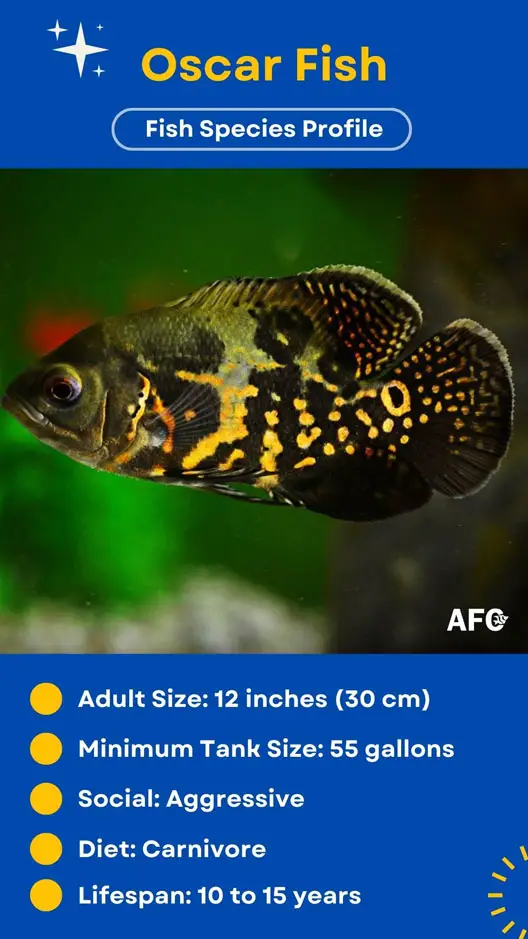
Discus Fish (Symphysodon spp.)
Discus fish (Symphysodon spp.) are a small genus of three tropical freshwater fish in the family Cichlidae. They are native to the Amazon River basin in South America. However, specimens available in the trade are mostly captive-bred from commercial fish farms in Asia.
Discus cichlids are characterized by their distinctive disc-shaped body and spectacular colors, including blue, red, yellow, green, white, and purple. New color morphs are constantly being produced by selective breeding.
Depending on the size of the fish and the rareness, the price of Discus fish can range between $25 to $550.
These brightly colored fish grow quite large, typically reaching 6 – 9 inches (15 – 23 cm) in diameter. They are one of the calm, peaceful cichlids in South America, making them great candidates for community tanks.
While discus fish are among the most challenging South American cichlids to keep because they require specialized water quality parameters and pristine water, and they are more timid than other species. As such, they are often relished by seasoned fish hobbyists alike.

Apistogramma Cichlid
Apistogramma is a species-rich genus of cichlids that are distributed in tropical South America east of the Andes, including Argentina, Brazil, Colombia, the Guyanas, Paraguay, Peru, Uruguay, and Venezuela.
The genus encompasses 93 recognized species and more than 400 undescribed species. The most common type is the cockatoo dwarf cichlid (A. cacatuoides). Other well-known members include Agassizi’s dwarf cichlid (A. agassizii), red shoulder dwarf cichlid (A. macmasteri), and yellow dwarf cichlid (A. borellii).
Apistogramma species are most commonly referred to as Apistogramma dwarf cichlids because of their compact size. These fish typically reach up to 3.0 to 3.5 inches (7.6 to 8.9 cm) in total length. The average lifespan of Apistogramma is about 2-5 years old.
Apistogramma cichlids have a very attractive coloration with striking patterns of spots and bars on their body. This, coupled with their relatively peaceful temperament, makes them the most popular beginner South American cichlids.
These fish prefer soft, acidic water and plenty of hiding places. Apistos are normally not aggressive toward other tankmates, though they can become extremely territorial and aggressive during the spawning season.

German Blue Ram (Mikrogeophagus ramirezi)
The German Blue Ram (Mikrogeophagus ramirezi) is a species of cichlid fish endemic to the Orinoco River basin in both Venezuela and Colombia. This striking fish is known by many common names, including Ram Chiclid, German Blue, Asian Ram, Butterfly Cichlid, Ramirez’s Dwarf Cichlid, Dwarf Butterfly Cichlid, and Ramirezi.
German Blue Rams are available in several color morphs, including Electric Blue Ram, Balloon Ram Cichlid, Angel Ram Cichlid, Longfin Blue Ram, and Gold Head Blue Ram. They reach a maximum size of about 2.5 inches (6.4 cm) in length and have an average lifespan of between two and three years.
The German Blue Ram is a long-time favorite in the dwarf cichlid hobby because of its bright colors and peaceful, easy-going personality. These fish do well in a well-established community tank. However, they have a reputation for being very delicate and demanding because of their very specific water requirements. They are not a good choice for beginners.
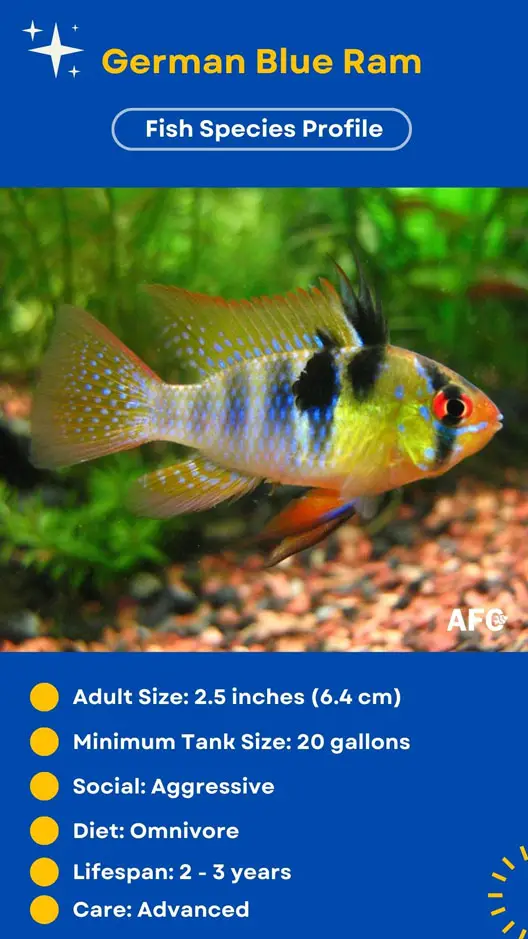
Bolivian Ram (Mikrogeophagus altispinosus)
The Bolivian Ram (Mikrogeophagus altispinosus), also known as the Bolivian Butterfly, Bolivian Ram Cichlid, and Ruby Crown Cichlid, is a species of cichlid fish endemic to the Guaporé River drainages in Bolivia and Brazil. It is not as brightly colored as its cousin, the German Blue Ram, but it is hardier and much easier to keep.
Bolivian Rams tend to be a bit larger than German Blue Rams, up to 3.5 inches (8.9 cm). Compared to German blue rams that require high temperatures of 84-86°F (29-30°C), Bolivian Rams can live in cooler temperatures of 73–79°F (23–26°C).
This underrated cichlid goes well with more community fish that prefer cooler water than its famous counterpart. Bolivian Rams are a good alternative if you really want to keep German Blue Rams but don’t have the right climate conditions.

Green Terror Cichlid(Andinoacara spp.)
Green Terrors are a common name for three closely related freshwater cichlid species: Andinoacara stalsbergi, Andinoacara rivulatus, and Andinoacara sp. Gold/Silver saum. These fish originates from the Pacific side of South America. To differentiate them from each other, A. stalsbergi is referred to as ‘True’ Greer Terror in the trade, while A. sp. Gold/Silver Saum is sometimes called the Fake Green Terror.
As the name implies, Green Terrors are quite aggressive cichlids. Be very careful when selecting tank mates for them. Only choose those of similar size who can hold their own against these feisty fish. Due to this, they are not suitable for a beginner’s aquarium.
Green Terrors are large South American cichlids. A. rivulatus is among the largest, reaching up to 12 inches (30 cm) in length. A. stalsbergi is a bit smaller, with a maximum length of 9 inches (23 cm). A. sp. Gold/Silver Saum is in between, typically growing to 10 inches (25 cm) long.
They are all great fish to keep. However, the ‘True’ Greer Terror (A. stalsbergi) is the best option if you’re looking for a more interesting and uncommon species.

Red Terror Cichlid (Mesoheros festae)
The ‘True’ Red Terror Cichlid, or Festae Cichlid, is a large freshwater fish of the cichlid family found in various fast-moving streams and slow, nearly stagnant water bodies in Ecuador and Northern Peru. The name “Red Terror” is also used in the trade for the Mayan cichlid (Mayaheros urophthalmus) because of its similarly vibrant red color. They are not easy to distinguish from younger fish.
The Ture Red Terror cichlid males grow to 12 inches (30 cm) in length and can reach full size in about two years.
‘True’ Red Terrors are more aggressive than the ‘True’ Greer Terrors and exhibit strong intraspecific aggression. The male in a compatible pair may suddenly develop aggressive behavior towards the female. Thus, it is best to house them with other South or Central American cichlids of similar size who can hold their own or keep them singly.
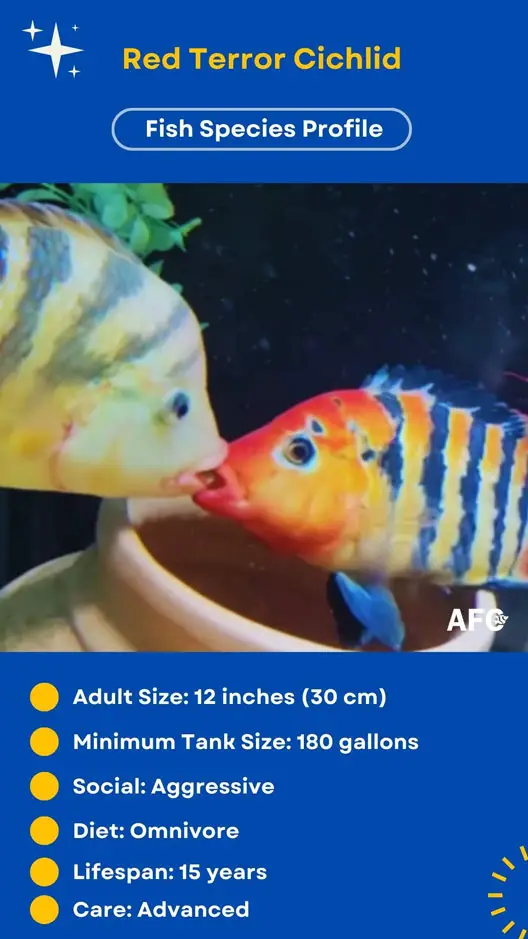
Blue Acara (Andinoacara pulcher)
The Blue Acara (Andinoacara pulcher) is a species of cichlid fish that originates from the Orinoco River and its tributaries in Venezuela and Trinidad, where various freshwater habitats exist. Its Latin name, pulcher, translates to “beautiful,” this species is aptly named for its steel blue-gray coloration.
The Electric Blue Acara is the captive-bred variant of the Andinoacara pulcher known for its bright, neon-blue body. This hybrid species was created by breeders cross-breeding the Andinoacara pulcher with Mikrogeophagus ramirezi (Blue Ram) to achieve a more stunningly beautiful fish.
Both Blue Acara and Electric Blue Acara are medium-sized cichlids, typically reaching around 6 inches (15 cm). Additionally, their peaceful nature and adaptability make them good candidates for South American cichlid community tanks.
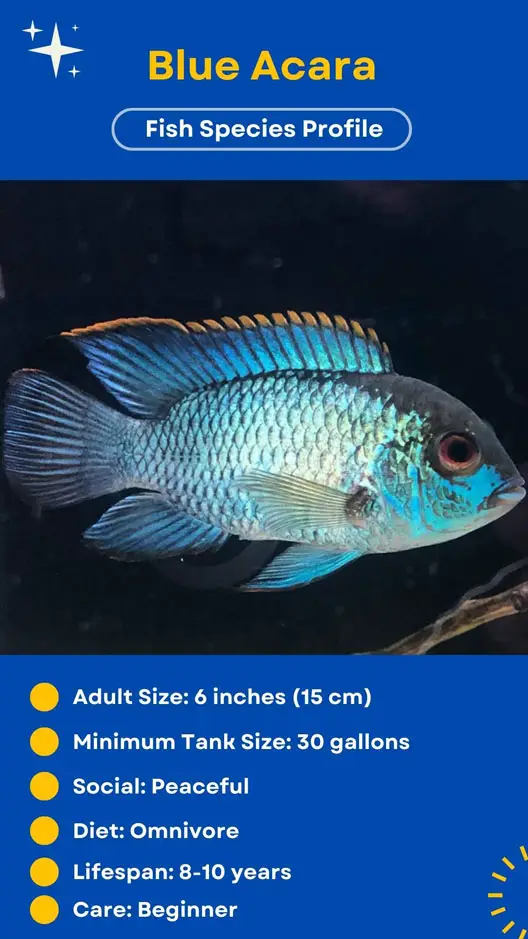
Freshwater Angelfish (Pterophyllum spp.)
The common name “freshwater angelfish” is used to refer to the three cichlid species of the genus Pterophyllum, including the widely available P. scalare, the largest P. altum, and the smallest and rarest P. leopoldi. These species are native to the Amazon Basin in Peru, Colombia, and Brazil.
Angelfish have a wide variation in their colors and patterns, such as koi, blue, marble, platinum, black lace, veil, gold, red devil, panda, veiltail, and silver. New types of angelfish are being developed every year through selective breeding.
Most angelfish available in the aquarium hobby grow to be 6 inches (15 cm) in length and a height of 8 inches (20 cm). They can live up to 12 years if provided with proper care. The price of angelfish depends on their size and strain, ranging from $25 to $100.
Freshwater angelfish will stay in the middle of the fish tank and are quite peaceful fish that can co-exist in a community tank with other bottom-dwelling fish. As with other cichlids in this list, they can be aggressive towards each other while spawning and caring for the fry.

Geophagus Cichlid
Geophagus, more commonly known as Geophagus eartheaters, is a diverse group of cichlids that are found in a wide range of habitats in South America. These fish are known for sifting through the substrate into their mouths to find food items such as invertebrates, plant material, and detritus.
There are 32 described species in the genus, and the readily available in the aquarium hobby are G. tapajos, G. altifrons, G. surinamensis, G. sveni, G. winemilleri, and G. brasiliensis.
Geophagus cichlids are medium-to-large fish, typically ranging from 4 to 6 inches (10 to 15 cm) in length. The pearl cichlid (G. brasiliensis) is the largest known species that can reach 11 inches (28 cm) in standard length.
Geophagus are popular aquarium fish due to their attractive appearance, relatively peaceful temperament, and unique social behavior. They are also easy to care for and reproduce, making them a good choice for cichlid beginners.
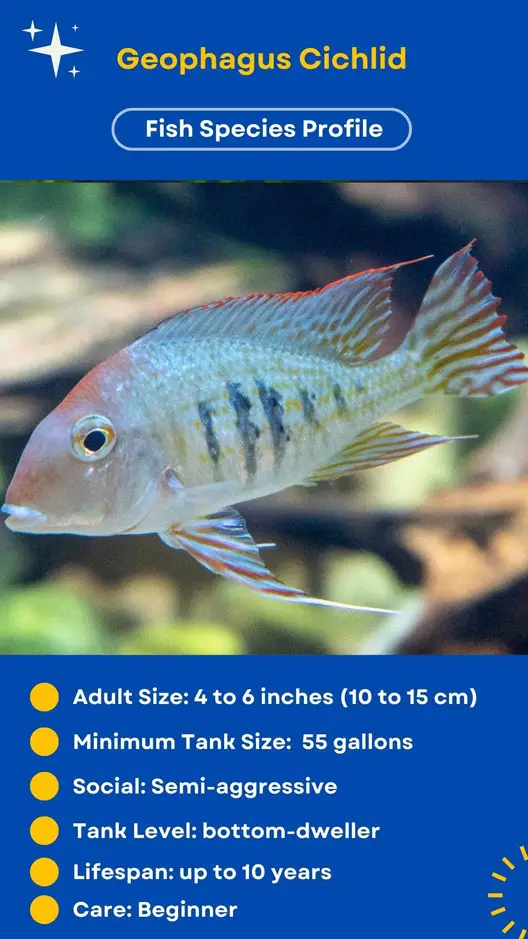
Keyhole Cichlid (Cleithracara maronii)
The Keyhole Cichlid is a freshwater fish that originates from the small, slow-moving clear water creeks and black water in the lower Orinoco River basin, the Barima River in Guyana, and the Ouanary River in French Guyana.
Keyhole cichlids attain a maximum total length of 4 inches (10 cm) when full-grown in captivity. They are easily identifiable by the distinctive dark spot on its head, which resembles a keyhole.
Arguably one of the most peaceful South American cichlids, the shy and reclusive keyhole cichlid is an excellent choice for a community tank. It’s also relatively hardy and undemanding when it comes to water parameters and can tolerate a wide range of conditions.
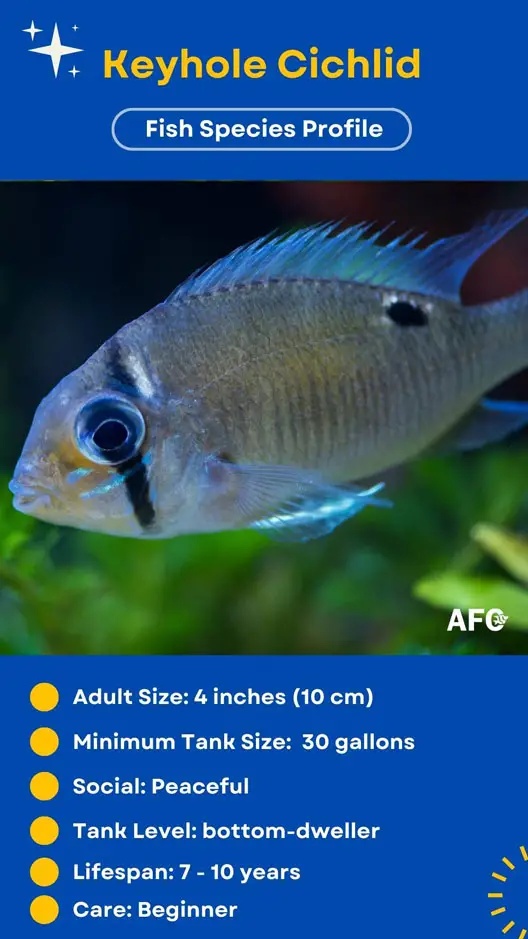
Pike Cichlid (Crenicichla spp.)
Pike cichlid is the common name that refers to the species of Crenicichla, the largest genus in the Cichlidae family in South America. They are commonly found in the La Plata River and drainages of several basins in the east of the Andes, such as the Orinoco, Amazon Basin, Paraná, and Tocantins.
Of the more than 90 valid species of Crenicichla, those dwarf pike cichlids no larger than 2.4 – 5.5 inches (6–14 cm) are the more popular members of this family. Medium to large-sized species, like Zebra Pike Cichlid (C. zebrina), Lenticulata Pike Cichlid (C. lenticulata), and Orange Xingu Pike Cichlid (C. sp. ‘Xingu I’) are also often kept by experienced aquarists.
Virtually all pike cichlids are aggressive and territorial species, including those dwarf pike cichlids like C. regani, C. heckeli, and C. wallacii, so they are not recommended for beginners. Plus, they are natural predators and fish eaters; they may attack any tankmates they could swallow.
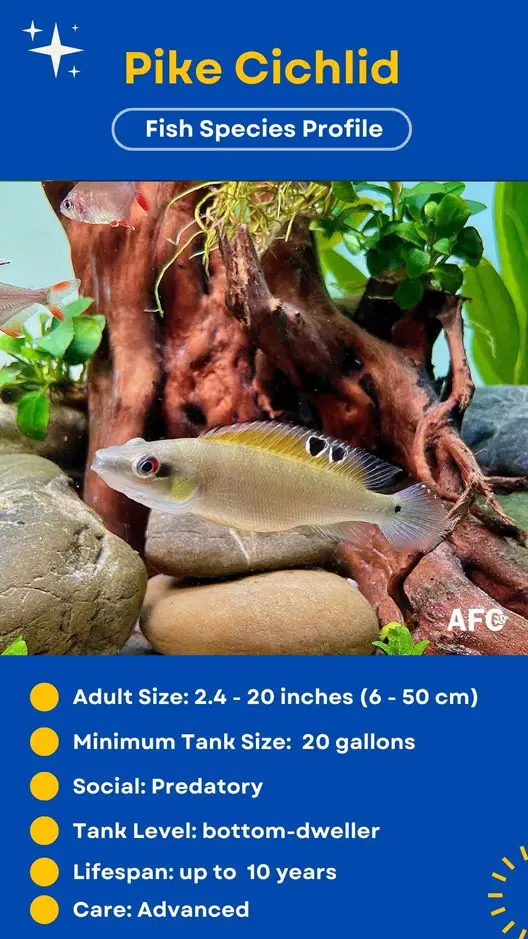
Chocolate Cichlid (Hypselecara temporalis)
The Chocolate cichlid is a 12 inches (30 cm) cichlid that hails from the Amazon and Orinoco basins in South America. It derives its common name from its deep brown or chocolate-like body color in males.
This large-sized South American cichlid is beloved by its enthusiasts for its impressive size, gentle nature, and interesting behavior. A breeding pair of chocolate cichlids will perform a series of jaw-locking courting behavior in which they face each other, open their mouths wide, and lock them together.
Chocolate cichlids are a fairly peaceful species that can be kept in a community tank, though they can become territorial when breeding. Like most other cichlids from the Amazon River Basin, they prefer slightly acidic, soft water with warmer temperatures.

Severum Cichlids (Heros spp.)
The common name “Severum cichlid” refers to several species of the genus Heros that are widespread throughout the Orinoco, Amazon, and Essequibo river basins in South America. These fish can be distinguished by 6-8 bony spines in the anal fin.
Severums are available in a variety of colors, including gold, green, red, turquoise, white, and blue. Contrary to popular belief, the Green or Turquoise Severum (Heros efasciatus) is hands down the most commonly kept species in the hobby, rather than Heros severus, which is a rare species that only inhabits blackwater environments.
Severums typically attain a length of about 6 to 8 inches (15 to 20 cm). The average lifespan of these fish is around five years.
Green Severums are relatively peaceful and can be kept with other semi-aggressive fish in a community tank. The main diet of Severum cichlids should provide plenty of vegetable matter to ensure good health, as they are known to eat fruit regularly in the wild, especially during the wet season when riparian zones become inundated with water.

Threadfin Acara (Acarichthys heckelii)
The Threadfin Acara (Acarichthys heckelii), also known as the Keckelii cichlid, is the only member of its genus. It is native to the Amazon lowlands in Peru, Colombia, Guyana, and Brazil, where it can be found in both stagnant and flowing blackwater and clear water habitats. This fish has also been widely introduced to southeastern Asia.
Threadfin Acaras are identified by their remarkable filament-like dorsal fin extensions, and they usually reach 8 inches (20 cm) in length. Multiple varieties of threadfin Acaras are available, but the albino threadfin acara is the most sought-after.
While the Keckelii cichlid is relatively peaceful, it will eat smaller fish, so it should only be kept with fish of a similar size. These fish spend the majority of their time in the middle of the water volume, making excellent tankmates for other bottom-dwelling South American Cichlids such as apistos and Geophagus.
Threadfin acaras are a part of the eartheater cichlid family, which means they like to dig and sift through the substrate for feeding, and they will often uproot plants that are not well-rooted.

Uaru Cichlid (Uaru amphiacanthoides)
The Uaru cichlid, or triangle cichlid (Uaru amphiacanthoides), is an endemic species only found in the blackwater habitats in the middle and lower Negro River basin in Brazil. It is a staple food fish in its native region, but it is now a popular aquarium fish due to its triangle-shaped body, visually impressive spawning colors, and intelligence.
Uaru cichlids reach a maximum length of 9.8 inches (25 cm) when full-grown. They generally reach maturity at around 4 inches (10 cm) in size.
Juvenile Uaru Cichlids are mottled in brown and black, but as they mature, their colors become brighter, and they develop a black teardrop-shaped mark on their sides. When they are ready to spawn, the mark will enlarge and be edged in brown or gray, and their eyes will turn a bright orange-red.
Uaru cichlids are very intelligent fish that can be trained to recognize their owners and respond to hand feeding. They are some relatively peaceful American cichlids and won’t bother your other fish as long as you provide a decent-sized tank with clearly defined boundaries.

True Parrot Cichlid (Hoplarchus psittacus)
The true parrot cichlid (Hoplarchus psittacus) is a tropical species of freshwater fish belonging to the cichlid family. It originates from the blackwater Amazon tributaries in Venezuela, Colombia, and Brazil.
In their native habitats, the water is very soft and slightly acidic (pH 5.5-6.0), with low levels of dissolved minerals. The water temperatures usually range from 77 to 86°F (25 to 30°C). They can adapt to moderately hard water (GH < 12 dGH) in the aquarium but need soft, acidic water conditions to spawn. An effort should be made to mimic the natural water conditions during the breeding season.
The true parrot cichlid is a large-sized South American cichlid, and the recorded maximum size is 14 inches (35 cm). True parrots are aggressive cichlids and should only be kept with other large, aggressive fish that can defend themselves.

Umbee Cichlid (Kronoheros umbriferus)
The Umbee Cichlid, also known as the Turquoise Cichlid, is the largest neotropical cichlid species. It originates from the Magdalena River Basin in Colombia and the Tuira River and Chucunaque River drainages in Panama.
There are three main geographic populations, including the most commonly seen blue umbee from the Magdalena basin of Colombia, the black umbee from the Pacific region in Colombia, and the rare green umbee from Panama.
This large and active fish can reach a maximum size of 20 inches (50 cm), so it will need to be kept in an aquarium with at least 180 gallons. Umbee Cichlids are fierce predators and should only be housed with fish too large to fit in their mouths. A single-species tank is best.

Festivum Cichlid (Mesonauta festivus)
The Festivum cichlid (Mesonauta festivus), often referred to as the flag cichlid, is a medium-sized, semi-aggressive, social cichlid species that originates in the Amazon River basins in Brazil, Peru, Bolivia, and Jamari.
This cichlid grows to 6-8 inches (15-20 cm) in total length. They are easily recognized by a bold black band that runs from the tip of their snout, across the eyes, and down to the extremities of the dorsal fin.
Like their closely related cousins, such as angelfish, discus, keyholes, and acaras, festivum cichlids are considered peaceful fish and generally show aggression during spawning. They are also socialized and prefer to hang out in loose groups, making them great additions to a larger community tank.
If you enjoy angelfish but are looking for a fish that is a bit more challenging to care for, festivums are a great option.

Checkerboard Cichlid (Dicrossus filamentosus)
The checkerboard cichlid is a member of the dwarf cichlid group and comes from shallow blackwater streams in the Orinoco and Rio Negro basins in Brazil, Colombia, and Venezuela. Two geographical variations of the checkerboard cichlid exist, with the Rio Negro variation being more attractive.
The males attain a length of 3.5 inches (9 cm), while the females reach a slightly smaller size of 2.4 inches (6 cm). The checkerboard cichlid has a brownish-orange body with an iridescent sheen along the lateral line, and the sides are marked with thin black vertical bars that form a checkered pattern resembling the game of chess.
The checkerboard cichlid is a relatively peaceful bottom-dwelling fish that can be kept in either community tanks or single-species setups. They prefer soft, acidic water and do best in planted tanks with plenty of hiding places. They are omnivorous and generally not picky eaters.
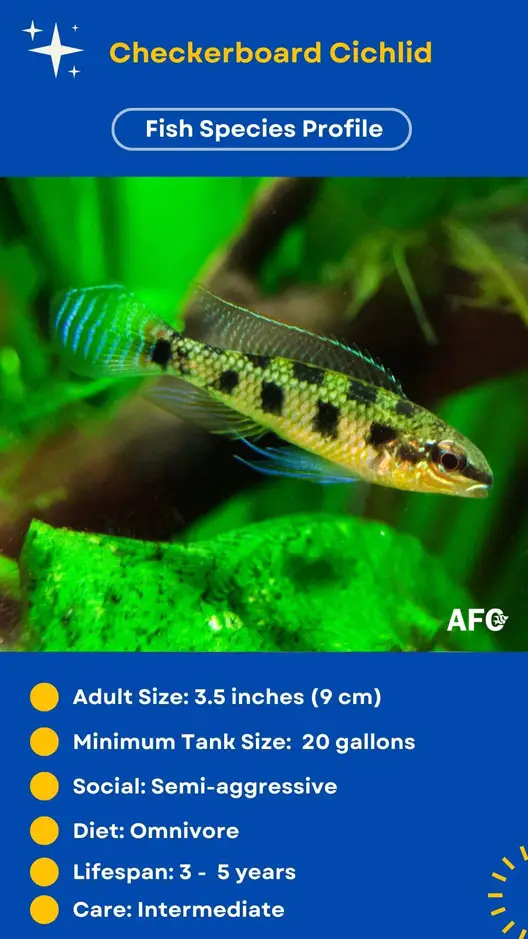
Golden Dwarf Cichlid (Nannacara anomala)
Nannacara anomala, also known as the golden dwarf cichlid or goldeneye cichlid, is a small cichlid species that is known from the Aruka River in Guyana east to the lower Marowijne River in Suriname, as well as the Pripri Yiyi wetland in French Guiana. Due to the different collected populations, this species has three wild forms in colors green, yellowish-green, and blue-green.
In the wild, the maximum standard length recorded for male Nannacara anomala is 2.2 inches (5.64 cm), and the female is 1.54 inches (3.91 cm). However, with optimal care in captivity, males can typically reach 3.1 inches (8 cm), and females can grow to 2.0 – 2.2 inches (5 – 5.5 cm).
Like most South American dwarf cichlids, like the Apistos and checkerboard cichlids, the golden dwarf cichlid is a relatively peaceful fish, and its active behavior makes it an ideal choice for a small community aquarium. They can be found in the same native habitat as many of the Apistogrammas. Thus, the care requirements are very similar. They should be kept in soft, acidic black water conditions to thrive and reproduce.

Kelberi Peacock Bass (Cichla kelberi)
The Kelberi Peacock Bass (Cichla kelberi) is a predatory cichlid that is native to the lower Tocantins River and Araguaia River drainage in Brazil. It has been selectively bred for the aquarium trade due to its prized colors and patterns. There are several different types of Kelberi Peacock Bass available, each with its own slightly different base color or spangle.
It can reach a maximum length of 18 inches (46 cm), but most specimens only grow to be 10-12 inches (25 – 30 cm) long in aquariums. They reach their full size in 16–18 months.
These large predatory South American cichlids can be kept with other large, robust tank mates that can defend themselves. They do well in small groups so that they will establish a dominant hierarchy among themselves, which will help to reduce aggression between fish.

What Are Rare South American Cichlids?
Listed below are some of the rare South American Cichlids.
- Ornatus Cichlid (Mesoheros cf. ornatus)
- Chocoheros microlepis
- Cichlasoma ornatum
- Panda Uaru (Uaru fernandezyepezi)
- Several eartheaters (Gymnogeophagus spp. and Geophagus spp.)
- Some pike cichlids (Crenicichla spp.)
- Some Apistogramma dwarf cichlids (Apistogramma spp.)
The list can be much longer as the rarity of South American cichlids is subjective. Fishkeepers sometimes refer to it as the “largest,” the “smallest,” or “most colorful” among a certain species. Others might consider it rare just because it isn’t often seen at local fish stores.
Generally speaking, wild-caught cichlids are more likely to be considered rare, especially those that live in the cool waters of Uruguay or those that hail from alkaline waters in the west of the Andes, as well as those that inhabit exclusively blackwater environments. Their rarity often stems from their specific water requirements and the intricacies of tank setup.
Additionally, species that require a permit for collection or importation from their native countries, or are close to extinction in the wild, are simply considered rare.
On the other hand, many man-made variants of the popular South American Cichlids and hybrids are classified as rare, for example, the Albino, Bloody, or Longfin Oscar fish, Albino Discus, or Golden Monkey flowerhorn.
What Are Large South American Cichlids?
Listed below are 10 of the large South American Cichlids.
- Umbee Cichlid (Kronoheros umbriferus)
- Oscar Fish (Astronotus ocellatus)
- Green Terror Cichlid (Andinoacara rivulatus)
- Red Terror Cichlid (Mesoheros festae)
- Chocolate Cichlid (Hypselecara temporalis)
- Striped Pike Cichlid (Crenicichla strigata)
- Kelberi Peacock Bass (Cichla kelberi)
- Pearl cichlid (G. brasiliensis)
- Geophagus altifrons
- Uaru Cichlid (Uaru amphiacanthoides)
Larger South American cichlids are often more aggressive than smaller ones and can be especially troublesome to their smaller tank mates. However, the Discus Fish, Chocolate Cichlid, Uaru Cichlid, and Geophagus altifrons tend to be rather peaceful, so they can be mixed with other species around their same size in a community tank at least larger than 125 gallons (473 liters).
What is The Largest South American Cichlid?
The speckled peacock bass (Cichla temensis), known as the speckled pavon, is the largest known South American cichlid. This species can grow up to 3.3 feet (1 meter) long and weigh up to 26.9 pounds (12.2 kilograms), as reported by FishBase. It is actually the largest American cichlid and possibly the largest extant cichlid in the world.
What Are the Most Aggressive South American Cichlids?
The most aggressive South American Cichlids are those large, predatory species, including Oscar fish, green terror cichlid, red terror cichlid, pearl cichlid, and striped pike cichlid, as well as other large fish that have large mouths and powerful jaws.
These fish must be kept in their own tanks or with compatible tank mates of similar size. They are known for their territoriality and aggression and can easily prey on anything small enough to fit in their mouth.
What Are Small South American Cichlids?
The following fish are some of the mall South American Cichlids.
- Apistogramma Dwarf Cichlid (Apistogramma spp.)
- German Blue Ram (Mikrogeophagus ramirezi)
- Bolivian Ram (Mikrogeophagus altispinosus)
- Checkerboard Cichlid (Dicrossus filamentosus)
- Golden Dwarf Cichlid (Nannacara anomala)
These diminutive cichlids are often called “dwarf cichlids” in the hobby, and they will do well in small-to-medium-sized aquariums of 10 – 20 gallons (38 – 75 liters). They are relatively peaceful, but many of them have earned a reputation for being more territorial and demanding.
What Are Medium-sized South American Cichlids?
The most popular medium-sized South American Cichlids include the following.
- Discus Fish (Symphysodon spp.)
- Blue Acara (Andinoacara pulcher)
- Freshwater Angelfish (Pterophyllum spp.)
- Geophagus Cichlid (Geophagus spp.)
- Keyhole Cichlid (Cleithracara maronii)
- Suriname Flame Pike Cichlid (Crenicichla multispinosa)
- Ringtail pike cichlid (Crenicichla saxatilis)
- Red Striped Eartheater(Geophagus Surinamensis)
- Sveni Eartheater Cichlid Parana (Geophagus sveni)
- Severum Cichlids
- Threadfin Acara (Acarichthys heckelii)
- Festivum Cichlid (Mesonauta festivus)
These mid-sized South American cichlids are semi-aggressive species and can play nice with other community fish as long as they are of similar size and temperament. The tank size should be at least 29 gallons (110 liters).
What Are the Most Peaceful South American Cichlids for Community Tanks?
The most peaceful South American cichlids for community aquariums include A. borellii, A. macmasteri, and keyhole cichlid. They are great beginner cichlids without the hassle of having to provide specific water parameters and tank environments.
What Are the Most Colorful Cichlids South American Cichlids?
Listed below are the most colorful South American Cichlids that exhibit full-spectrum colors.
- Oscar Fish
- Discus Fish
- Apistogramma Cichlid
- German Blue Ram
- Bolivian Ram
- Green Terror Cichlid
- Geophagus Cichlid
- Severum Cichlid
- True Parrot Cichlid
South American Cichlids come in every color, most commonly blue, yellow, red, orange, purple, green, and pink. Some species even display a rainbow of colors on their bodies, making any tank look gorgeous. New mutations of the Oscar and Angelfish species also add even more variety to the options available.
What Are The Blue South American Cichlids?
Listed below are the most popular blue South American Cichlids.
- Blue Oscar Fish
- Blue Discus Fish
- Apistogramma sp. ‘Steel Blue’
- Apistogramma agassizi ‘Neon Blue’
- Apistogramma borelli
- Blue Acara
- German Blue Ram
- Green Terror Cichlid
- Pearl Cichlid
- Geophagus altifrons
- Blue Zebra Angelfish
- Blue Severum Cichlid
- Umbee Cichlid
- Golden Dwarf Cichlid
- Thai Silk Flowerhorn
What Are The Yellow and Orange South American Cichlids?
Listed below are the most popular yellow and orange South American Cichlids.
- Lemon Yellow Oscar
- Yellow Discus Fish
- Apistogramma allpahuayo ‘Yellow’
- Apistogramma cf. agassizii ‘Golden’
- Apistogramma viejita ‘Gold’
- Apistogramma cacatuoides ‘Orange Flash’
- Bolivian Ram
- Threadfin Acara
- Red Terror Cichlid
- Koi Angelfish
- Geophagus pellegrini
- Keyhole Cichlid
- Uaru Cichlid
- Festivum Cichlid
- Checkerboard Cichlid
- Golden Dwarf Cichlid
- Kelberi Peacock Bass
What Are The Red South American Cichlids?
Listed below are the most popular red South American Cichlids.
- Red Oscar
- Red Discus Fish
- Apistogramma cf. agassizii ‘Double Red’
- Apistogramma agassizii ‘Fire Red’
- Apistogramma cacatuoides ‘Triple Red’
- Apistogramma cacatuoides ‘Super Red’
- Red Devil or Super Red Angelfish
- Red Head Tapajos (Geophagus pyrocephalus)
- Red Atabapo Pike Cichlid
- Chocolate Cichlid
- Red Spotted Severum
- Blood Parrot Cichlid
What Are The Purple South American Cichlids?
Listed below are the most popular purple South American Cichlids.
- Purple Discus fish
- Purple Rose Queen Cichlid
- Purple Jellybean Parrot Cichlid
- Purple Flowerhorn Cichlid
What Are The Pink South American Cichlids?
Listed below are the most popular pink South American Cichlids.
- Pink Discus fish
- Pink Angelfish
- Pink Tail Chalceus
What Are The Green South American Cichlids?
Listed below are the most popular green South American Cichlids.
- Green Oscar Fish
- Green Discus
- Green Terror Cichlid
- Bulgarian Green Angelfish
- Green Horseface Eartheater (Geophagus jurapari)
- Compressiceps Dwarf Pike Cichlid
- Green Severum
What Are the South American Cichlid Hybrids?
These three species are the most recognized South American cichlid hybrids in the commercial market.
- Blood Parrot Cichlid. This hybrid was created by crossing the Midas Cichlid and the Red Devil Cichlid.
- Flowerhorn Cichlid. This hybrid was created by crossing several different species of cichlids.
- Red Texas Cichlid. This hybrid was created by crossing a male Texas cichlid (Herichthys cyanoguttatus) with a female Red Parrot cichlid or Flowerhorn Cichlid.
What Are The Differences Between South American Cichlids Versus African Cichlids?
The differences between South American and African cichlids include origin, social behaviors, water parameters, habitat, and diet.
- Origin: South American cichlids originate from rivers, lakes, and streams throughout South America, while African cichlids primarily come from the African Great Lakes, such as Lake Malawi, Lake Tanganyika, and Lake Victoria.
- Social behavior: South American cichlids are generally less aggressive and have more playful personalities than African cichlids.
- Water parameters: South American cichlids prefer soft, acidic water, while African cichlids do best in hard, alkaline water.
- Habitat: South American Cichlids tend to inhabit slower-moving waters with abundant vegetation, while most African cichlids live in either open water or rocky spaces with strong currents.
- Diet: South American cichlids are generally omnivores and carnivores, while many African cichlids from Lake Tanganyika are herbivores.
To help to reduce aggression in African cichlid aquariums, cichlid hobbyists often overcrowd the tank with large groups to spread out aggression. More fish means more waste and more maintenance.
Can You Mix African and South American Cichlids?
Yes, you can mix African Cichlids with non-predatory South American cichlids in the same tank because they are mostly captive-bred fish that will adapt to the water chemistry parameters. However, we strongly advise against mixing them unless you are an old hand at keeping cichlids.
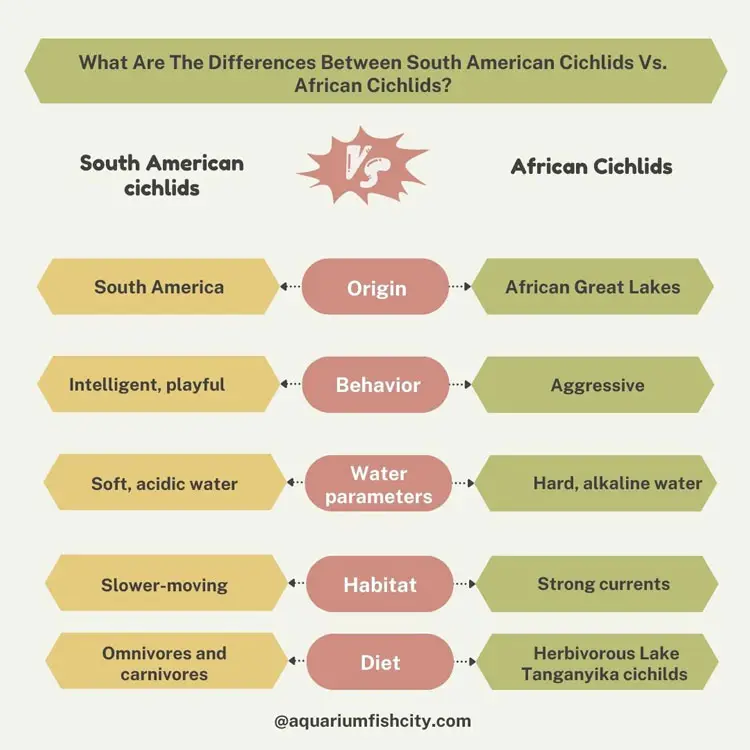
What Are The Differences Between Central and South American Cichlids?
The main differences between Central and South American cichlids are their geographic distribution, natural habitats, and aggression.
- Geographic distribution: Central American cichlids in the wild are found in Central America and the lower regions of North America, while South American cichlids are found in South America.
- Natural habitats: Central American cichlids often come from regions with a higher limestone content, which results in hard and alkaline water, with a pH usually above 7.6. South American cichlids, on the other hand, tend to prefer softer, more acidic water.
- Aggression: Central American cichlids tend to be more aggressive and territorial than South American cichlids because of the water temperature and resource competition.
Can You Mix Central and South American Cichlids?
Yes, you can mix Central and South American Cichlids as long as you choose species similar in size and aggression level. Avoid overly aggressive fish such as jaguar cichlid, pearlscale cichlid, and wolf cichlid.
It’s also important that your tank has enough space to provide territories for each to control. Unlike African cichlids, overstocking should not be practiced with Central and South American Cichlids to lessen aggression.
What to Know for Choosing the Right South American Cichlid Type?
Listed below are the questions to consider when choosing the right type of South American cichlid.
What Type of South American Cichlids Tank Do You Want?
The common types of South American Cichlids aquariums are listed below.
- Community Tank: This type of tank can be filled with different types of South American cichlids, live plants, and other bottom dwellers like shrimp or snails. Small- to mid-sized fish are best for community tanks.
- Cichlid Breeding Tank: A separate breeding tank is important if you want to be successful in breeding South American cichlids.
- Aquascaping Tank: Planted aquascapes look great with colorful, semi-aggressive types of cichlids, such as Apistogramma dwarf cichlids, Electric Blue Acara (EBA), Rams, or other species that will not dig and uproot plants.
- Predator Tank: Predator tanks are specialized tanks that must be dedicated to one or more types of predator South American cichlids, such as Oscar fish, pearl cichlid, striped pike cichlid, or peacock bass cichlid.
- Biotope Tank: Biotope tanks are designed to recreate the natural habitat of certain South American cichlid species, such as the popular Rio Negro Amazon Biotope Aquarium.
What Fish Can Live With South American Cichlids?
These are some potential tank mates for South American Cichlids.
- Dither fishes: These are small, fast-moving fish that help to distract aggressive cichlids and change the dynamics of the tank. Some good choices include tetras, hatchetfish, and pencilfish. They can coexist harmoniously with small and mid-sized South American cichlids.
- Small-to-mid-sized catfishes: These fish are peaceful and highly social. Often serve as clean-up crew fish that keep the tank clean by eating algae and other debris. Some good choices include corydoras catfish, otocinclus catfish, pictus catfish, bumblebee catfish, hoplo catfish, and bristlenose pleco. It is best to keep them in schools with small and mid-sized South American cichlids.
- Certain Central American cichlids: Some Central American cichlids, such as the convict cichlid, firemouth cichlid, and jack dempsey cichlid, can be compatible with larger South American cichlids.
- Oddballs: Some unusual fish, such as small stingrays, silver dollar fish, and black ghost knifefish, can also make possible tank mates for South American cichlids.
The best tank mates for your South American cichlids will depend on the individual fish, the size and shape of your tank, the water parameters, and other environmental factors. Before introducing any new fish, research whether they can co-exist happily within a community aquarium.
What Are the Water Parameters for South American Cichlids?
The most important water chemistry parameters for South American Cichlids include pH, General Hardness (GH), KH (Carbonate Hardness), and temperature.
- pH: pH measures the acidity of water. The pH level for most South American cichlids is 6.5-7.4. However, it can vary depending on the species. Some fish are known for their blackwater habitats with a pH as low as 4.0 or lower.
- GH: GH measures the amount of calcium and magnesium dissolved in water. South American cichlids can live in moderately hard water with a GH of 12 dGH (210 ppm).
- KH: KH measures the amount of carbonates and bicarbonates in water, also known as the buffering capacity of water. The optimal GH range for most South American cichlids is 4-8 dH (71-142 ppm). You’ll need to lower the KH to 0-3 dKH (0-50 ppm) if you wish to attempt to breed certain species like A. elizabethae or wild discus.
- Temperature: Most South American cichlids do best with a water temperature between 24 – 27°C (75 – 80°F).
Do South American Cichlids Like Currents?
Most South American cichlids do not like strong currents. Unlike African cichlids, they are well adapted for life in slow-moving or still waters, such as the Amazon River and its tributaries.
However, many large, powerful predators, like Pike Cichlids and Peacock Bass, prefer well-oxygenated water with plenty of currents.
What is The Best Substrate for South American Cichlids?
The best substrate for South American cichlids is fine white sand with a grain size of 0.5-1.7 mm and a depth of 1-1.5 inches (2.5-3.8 cm). This is important for eartheater cichlids like apistos, Geophagus, and threadfin acaras due to their sand-sifting feeding behavior. A sandy substrate also works like a charm to improve the overall aesthetic appeal of a South American cichlid aquarium.
What Size Tank for South American Cichlids?
The minimum tank size for South American cichlids depends on the specific species and how many fish you plan to keep in the aquarium. However, some general guidelines include the following.
- A pair or trio of dwarf cichlids: 20-40 gallons (75-151 liters)
- A pair or group of medium-sized cichlids: At least 29 gallons (110 liters)
- Large cichlids: At least 55 gallons (208 liters)
What Do South American Cichlids Eat?
South American cichlids feed on micro worms, insects, insect larvae, zooplankton, tiny invertebrate, and any other small fish that can fit in their mouths in the wild. Some species also eat plant matter like algae and detritus.
Since most of them are raised in captivity, the best food for South American cichlids is a quality cichlid pellet or flakes supplemented with both meaty treats and vegetables such as bloodworms, brine shrimp, daphnia, krill, earthworms, glass worms insect larvae, spirulina, and other algae-based foods. Remember, even the predators need some veggies too.
Wild-caught fish are often picky eaters and may not readily eat a pelleted diet. Provide live foods when possible and gradually wean them onto homemade gel food.
Can You Put Live Plants with South American Cichlids?
Yes, you can put live plants with South American cichlids. However, South American cichlids are not always known for being plant-friendly. Most mid-sized and large species possess instinctive digging behavior, which can uproot or damage delicate plants.
Choose more resilient plants, like anubias, java ferns, crypts (cryptocoryne spp.), Amazon Sword, and Vallisneria. Floating plants like Anacharis, Amazon Frogbit, Dwarf Water Lettuce, and Butterfly Fern are appreciated by fish that live under the forest canopy.
How Long Do South American Cichlids Live?
The longevity of South American cichlids ranges from 2 to 15 years. Factors such as water quality, diet, tank size, stress levels, and aquarium disease all play a role in determining how long your South American cichlids will live.
